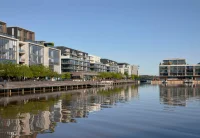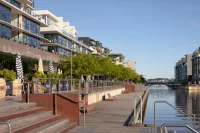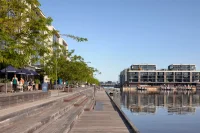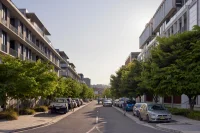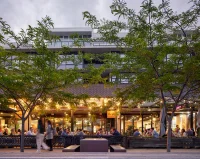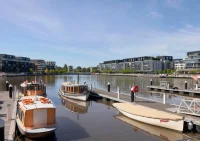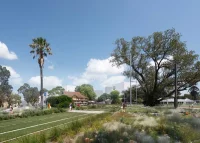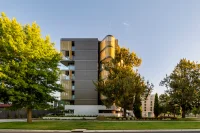Kingston ForeshoreHandmade
Hand-drawn by our founder, Colin Stewart, at his kitchen table for a national ideas competition just hours before the deadline, the Kingston Foreshore masterplan fulfils a long-held dream of connecting a central Canberra suburb to the water’s edge. Two decades later, it is also a lesson in slow city-making, with the masterplan now nearing completion along almost identical lines to those he originally sketched.
Hand-drawn by our founder, Colin Stewart, at his kitchen table for a national ideas competition just hours before the deadline, the Kingston Foreshore masterplan fulfils a long-held dream of connecting a central Canberra suburb to the water’s edge. Two decades later, it is also a lesson in slow city-making, with the masterplan now nearing completion along almost identical lines to those he originally sketched.
Location
Kingston
State
ACT
Country
Ngunnawal
Client
Land Development Agency
Expertise
Master Plan, Urban Design
Year
1997
Photography
Tom Roe
1/6
Brief
The project to develop the Kingston Foreshore onto Lake Burley Griffin was initiated by the ACT Government in the mid-1990s. For Stewart Architecture, the competition for the masterplan offered an opportunity to test our theories about urban design, resurrecting some of the original ideas about Canberra’s urban plan articulated by its master planner (and the lake’s namesake) Walter Burley Griffin and his wife Marion almost a century ago. Our masterplan – like many undertaken by the practice – began with a holistic vision, a set of ideas about urban structure, density and use. It wasn’t designed specifically for housing or offices or culture; it was designed as an armature for incremental development over the longer term, accommodating almost any potential mix of uses.
“The thing about Kingston is waterfront interaction. While Canberra is built on a lake, unless you’re walking along it, there’s not a whole lot of lakeside amenity elsewhere.” - Anton Scott-Cameron, Designer.
The project to develop the Kingston Foreshore onto Lake Burley Griffin was initiated by the ACT Government in the mid-1990s. For Stewart Architecture, the competition for the masterplan offered an opportunity to test our theories about urban design, resurrecting some of the original ideas about Canberra’s urban plan articulated by its master planner (and the lake’s namesake) Walter Burley Griffin and his wife Marion almost a century ago. Our masterplan – like many undertaken by the practice – began with a holistic vision, a set of ideas about urban structure, density and use. It wasn’t designed specifically for housing or offices or culture; it was designed as an armature for incremental development over the longer term, accommodating almost any potential mix of uses.
“The thing about Kingston is waterfront interaction. While Canberra is built on a lake, unless you’re walking along it, there’s not a whole lot of lakeside amenity elsewhere.” - Anton Scott-Cameron, Designer.
Design
The masterplan develops many ideas that have become a signature in our practice.
It is for a human neighbourhood, of modest scale with distinct public spaces that are walkable and connected. Closely connected to the water, the urban environment has a very different feel to other parts of the city, where the natural point of connection is to the surrounding bush. The hard landscape steps directly to the lake, forming a circuit along the foreshore popular with walkers and runners, and reminiscent of harbourfront developments in maritime cities such as Oslo. This is faced by an active layer of retail and restaurants at street level, with apartments and offices above, and fronted by pontoons and boat docks.
Three of the lakefront residential buildings – Bridge Point, Dockside and Azure – have also been designed by Stewart Architecture.
The masterplan develops many ideas that have become a signature in our practice.
It is for a human neighbourhood, of modest scale with distinct public spaces that are walkable and connected. Closely connected to the water, the urban environment has a very different feel to other parts of the city, where the natural point of connection is to the surrounding bush. The hard landscape steps directly to the lake, forming a circuit along the foreshore popular with walkers and runners, and reminiscent of harbourfront developments in maritime cities such as Oslo. This is faced by an active layer of retail and restaurants at street level, with apartments and offices above, and fronted by pontoons and boat docks.
Three of the lakefront residential buildings – Bridge Point, Dockside and Azure – have also been designed by Stewart Architecture.
Impact
Slowly emerging over twenty years, the master plan has not only been formative to our own approach, but also in developing the wider neighbourhood around it. A cluster of older structures behind the waterfront is undergoing restoration to create a precinct of arts buildings, connected to and feeding off the Foreshore development. These include The Fitters Workshop, a listed structure designed in 1917 as part of an industrial complex, now documented and restored by us to public use.
Slowly emerging over twenty years, the master plan has not only been formative to our own approach, but also in developing the wider neighbourhood around it. A cluster of older structures behind the waterfront is undergoing restoration to create a precinct of arts buildings, connected to and feeding off the Foreshore development. These include The Fitters Workshop, a listed structure designed in 1917 as part of an industrial complex, now documented and restored by us to public use.
Awards
2009
National Award for Excellence, Urban Renewal, Urban Development Institute of Australia
1999
Winner, Planning Excellence, Planning Institute of Australia
1997
First Prize, Design Competition, ACT Government
2009
National Award for Excellence, Urban Renewal, Urban Development Institute of Australia
1999
Winner, Planning Excellence, Planning Institute of Australia
1997
First Prize, Design Competition, ACT Government
